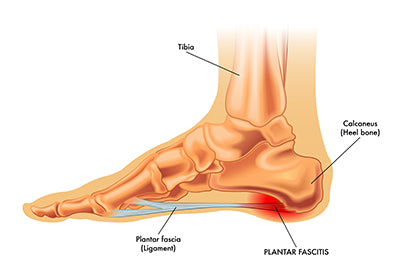
What is Plantar Fasciitis?
 Plantar fasciitis occurs when the plantar fascia, the tissue that goes along the bottom of the foot from the toes to the heel, becomes inflamed or swollen. Heel pain is one of the most common symptoms of plantar fasciitis, and there are a number of reasons why plantar fasciitis could occur. Pain and symptoms of plantar fasciitis can vary person to person and can be both intermittent and persistent. While it normally develops slowly, plantar fasciitis pain can also appear suddenly and be very intense. Symptoms to look out for include:
Plantar fasciitis occurs when the plantar fascia, the tissue that goes along the bottom of the foot from the toes to the heel, becomes inflamed or swollen. Heel pain is one of the most common symptoms of plantar fasciitis, and there are a number of reasons why plantar fasciitis could occur. Pain and symptoms of plantar fasciitis can vary person to person and can be both intermittent and persistent. While it normally develops slowly, plantar fasciitis pain can also appear suddenly and be very intense. Symptoms to look out for include:
- An aching feeling in the heel when you sit after walking
- First thing in the morning, the pain is at its worst
- Pain that increases over time
- Stabbing, sharp pain in the bottom of the heel
- Swollen heels
- Worsening pain when you tip toe, climb or stand
Practicing self-care by wearing medical foot alignment socks is an excellent way to help relieve some of the pain, but if these symptoms are severe, it is advised that you seek medical attention and foot alignment socks may be able to help while you are waiting for your doctor's appointment.
Causes of Plantar Fasciitis
The most common cause of plantar fasciitis is known as a biomechanical imbalance. This imbalance causes the soft tissues in the bottom of the foot to inflame and usually happens with excessive running, walking, dancing or jogging. Even non-athletic activities such as moving heavy objects can cause plantar fasciitis. Other causes include:
- Activity increase
- Arthritis
- Diabetes
- Flat feet
- High arches
- Improperly fitting shoes
- Lack of arch support
- Obesity
- Tight Achilles tendon
Issues can also be caused by the way you walk. For instance, if your arch flattens when you walk, the plantar fascia is stretched too much and can become inflamed. Weight gain is also a problem, especially when a woman is pregnant, as she has to learn how to walk in a new way to accommodate the weight.
Plantar fasciitis plagues a lot of people, but most commonly women over 40. No matter the cause, there are preventative measures such as stretches you can do when you wake up and wearing foot alignment socks a few hours each day. If the condition is debilitating, it is worth seeing your doctor to help treat it. For some exercises, check out our article "Plantar Fasciitis: Exercises to relieve pain"
Share this post
- Tags: foot pain, plantar fasciitis